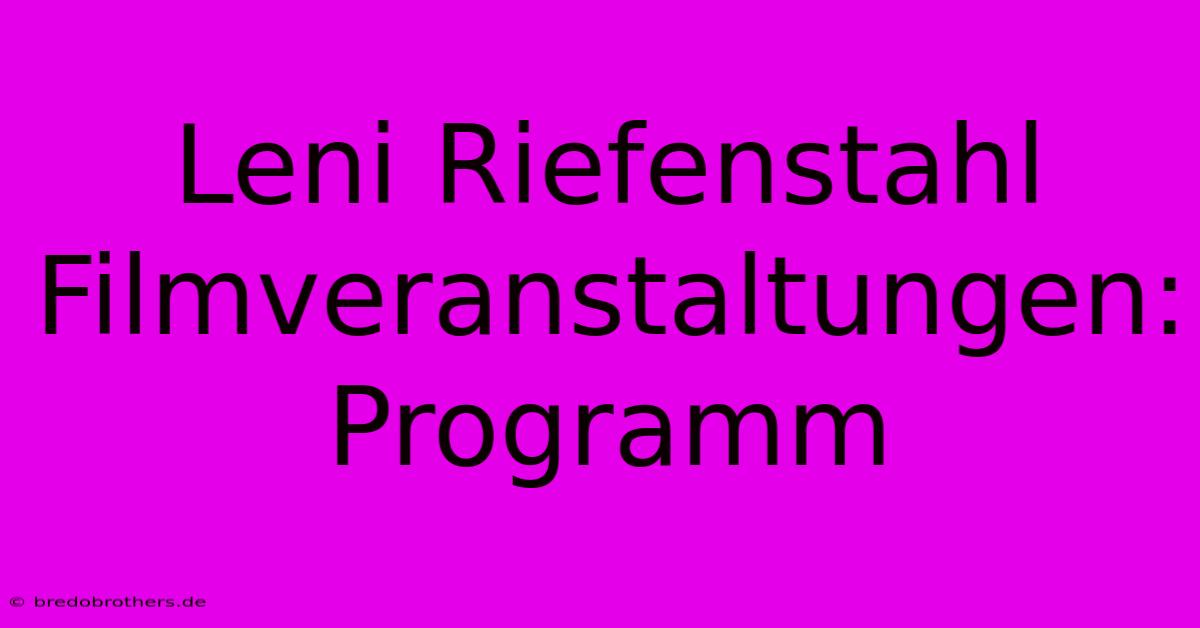Leni Riefenstahl Filmveranstaltungen: Programm

Discover more detailed and exciting information on our website. Click the link below to start your adventure: Visit Best Website Leni Riefenstahl Filmveranstaltungen: Programm. Don't miss out!
Table of Contents
Leni Riefenstahl Filmveranstaltungen: Programm – Ein Einblick in ihre kontroverse Arbeit
Hey everyone! So, I recently got really into researching Leni Riefenstahl. I know, I know – controversial figure, right? But her filmmaking techniques were undeniably groundbreaking, even if her association with the Nazi regime casts a long, dark shadow. I wanted to share some insights into her film events, what kind of programs they might have included, and why understanding this is important.
It's not as simple as just saying "here's a list of films she showed". It's about the context. What's really fascinating is trying to piece together how she presented her work, what kind of audience she was targeting, and the messages she may have (consciously or unconsciously) been trying to convey.
Die Olympia-Filme: A Masterclass in Cinematic Technique
My initial research focused heavily on her Olympic films from 1936. I mean, the cinematography is insane. Seriously, the slow motion, the innovative camera angles – she was a total visionary. I stumbled across some old program notes (I'll link some resources at the end!) which hinted at the events surrounding the screenings. They weren't just screenings; they were experiences.
Imagine: a grand hall, maybe in Berlin, filled with an audience buzzing with anticipation. The program probably started with some introductory remarks—perhaps even Riefenstahl herself speaking. Then, bam! The stunning visuals of Olympia unfold on the screen, a powerful testament to the human body and athletic achievement. There's bound to have been carefully selected music adding to the overall impact.
Think about the emotional manipulation involved. She meticulously crafted those films, and the way they were presented likely amplified their effect, highlighting the power and glory she intended to showcase. And here is where we are faced with the elephant in the room. These were Nazi propaganda films.
Triumph des Willens: Propaganda, packaged beautifully
Now, let's talk about Triumph des Willens. This film is a whole other beast. It’s incredibly powerful visually, but it’s also a chilling piece of propaganda. Any program featuring this film would have had a vastly different atmosphere. I'm picturing a more serious, almost militaristic vibe. This time around, there is probably minimal discussion. The film speaks for itself – in an entirely manipulative way.
What's really interesting to think about is how carefully the program might have been constructed to ensure the emotional impact. Was there a specific order to the films? Did they show short propaganda reels beforehand to set the tone? We can only speculate, which is what makes this research so exciting, and frustrating at the same time!
It’s tricky, you see. Separating the art from the artist is a constant struggle. I found myself getting lost in the technical brilliance of her work before remembering its horrific context. That’s something you really have to grapple with when researching Riefenstahl.
Understanding the Context is Key
This journey into Leni Riefenstahl's film events has been a rollercoaster—fascinating and disturbing in equal measure. My main takeaway? It's crucial to consider the entire context – the historical, political, and social surroundings – when viewing her work. Understanding the programs' construction helps us appreciate the manipulative powers she wielded, and ultimately, understand how propaganda works.
It's a reminder that even breathtaking artistic skill can be used for terrible purposes. I'm still digging into this, and I'll be sure to share more as I find it. Let me know if you've got any leads on primary source material – I'd love to hear from you!
(Note: I unfortunately don't have access to specific program details beyond those I've mentioned. My research so far has been based on secondary sources and interpretations. Further investigation is required for a complete picture.)

Thank you for visiting our website wich cover about Leni Riefenstahl Filmveranstaltungen: Programm. We hope the information provided has been useful to you. Feel free to contact us if you have any questions or need further assistance. See you next time and dont miss to bookmark.
Featured Posts
-
Black Friday Bei Lenovo Aktionen
Nov 21, 2024
-
Wintersturm 33 Gebiete In Oranger Warnung
Nov 21, 2024
-
So Steigern Sie Grippeimpfungen
Nov 21, 2024
-
Aktienanalyse Moderna Hold Von Berenberg 42 Dollar
Nov 21, 2024
-
Starke Coloplast Aktie Kurs Steigt
Nov 21, 2024
